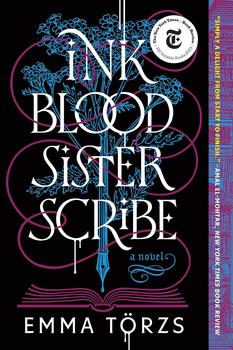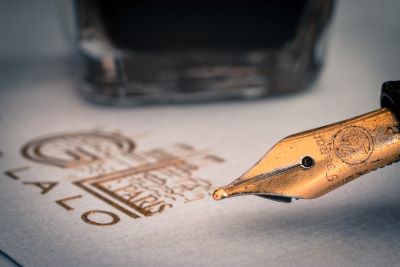Summary | Excerpt | Reviews | Beyond the Book | Read-Alikes | Genres & Themes | Author Bio

A Novel
by Emma TorzsThis article relates to Ink Blood Sister Scribe
 In Emma Törzs's Ink Blood Sister Scribe, the first word of the title plays an important role: By mixing blood with herbs, people can make ink with magical properties. In the real world, writing has been done with a variety of materials throughout history — including, from time to time, blood.
In Emma Törzs's Ink Blood Sister Scribe, the first word of the title plays an important role: By mixing blood with herbs, people can make ink with magical properties. In the real world, writing has been done with a variety of materials throughout history — including, from time to time, blood.
Evidence points to ink first being used in Egypt circa 3200 BCE, and in China around the same time. These inks were often carbon-based, created by mixing soot with binding agents like acacia gum. Iron gall ink, which was common in medieval and early modern Europe, is a mixture that incorporates gall nuts (a protective growth on oak trees that results from wasp nests) and ferrous sulfate. A reaction between these ingredients makes the muddy brown liquid created from boiled gall nuts turn into the deep blue-black that survives on many early modern manuscripts today.
However, even before these inks came into play, other substances had been used as a medium for human expression and communication, and blood was one of them. Prehistoric paintings have been found to contain animal blood in addition to plant sap and rock-based material. Later, "blood writing," or the practice of copying sacred texts in one's own blood, was common in Chinese Buddhism. According to an article by Erica X Eisen in The Paris Review, this practice began in the 6th century and continued into the early 20th century. Scribes would collect blood from "ritually potent places," such as wrists or tongues, believing that it represented "the state of the soul." Early Chinese accounts also mention pacts being "secured with blood," a concept that has emerged in other cultures and eras as well. It is clear that in these situations, blood was considered to have sacred properties. A similar sentiment is represented with literal magic in Ink Blood Sister Scribe, in which the characters use their blood to write spells.
There are many different kinds of ink today. Although their makeups are somewhat similar, unique materials in each help them achieve their intended purpose. The ink in ballpoint pens, for example, is made of alcohols and fatty acids; the thickness of the resulting material means less bleedthrough, but also necessitates more pressure to make the ink flow. Gel inks have powder suspended in, as one would expect, gel, which is water-based, rather than oil-based like in ballpoint pens. This helps gel ink write more smoothly and vividly, but also makes it more prone to smudging. Fountain pen inks, like gel inks, are water-based. They include dyes (most commonly eosin and triarylmethane) and pH modifiers, which help to minimize corrosiveness.
While modern inks might seem a far cry from historical blood writing, or from fantasy worlds like the one in Ink Blood Sister Scribe, the idea of blood as a powerful medium is present in contemporary times — such as in the expression "signed in blood," which emphasizes the loyalty or sacrifice present in an agreement. In keeping with this, you can find inks with names that evoke the concept — I've personally used and loved Diamine "Writer's Blood" ink in fountain pens.
Photo of fountain pen, via Pexels
Filed under Cultural Curiosities
![]() This "beyond the book article" relates to Ink Blood Sister Scribe. It originally ran in June 2023 .
This "beyond the book article" relates to Ink Blood Sister Scribe. It originally ran in June 2023 .






Your guide toexceptional books
BookBrowse seeks out and recommends the best in contemporary fiction and nonfiction—books that not only engage and entertain but also deepen our understanding of ourselves and the world around us.